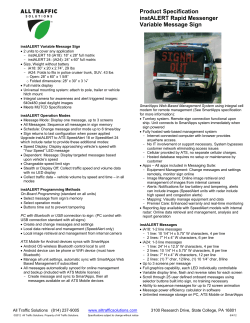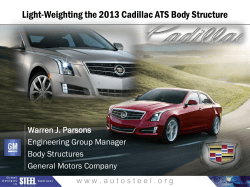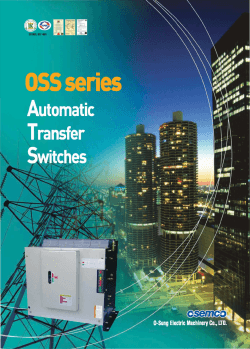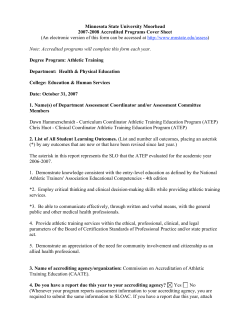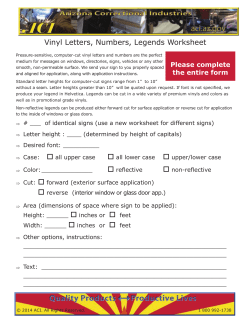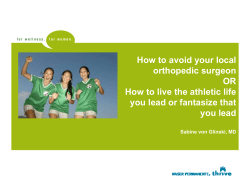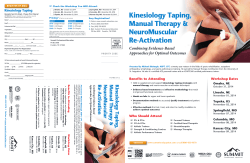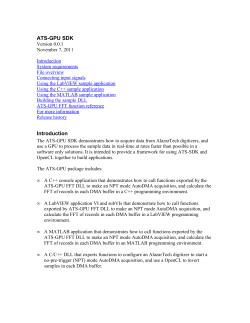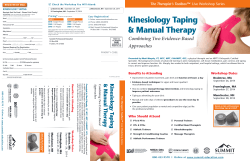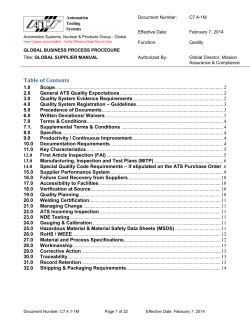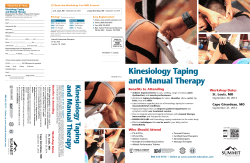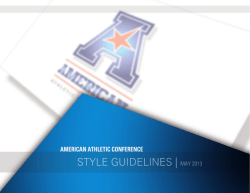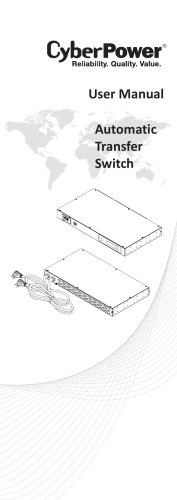
HHPA 214 – Preventative Techniques in Athletic Training Office Phone Email
HHPA 214 – Preventative Techniques in Athletic Training Spring 2012 Location: Field House 005 Tuesday 2-3:50pm / 1 semester hours Forestt Bridges, MS, ATC, LAT Interim Instructor / Clinical Coordinator of Athletic Training Education Office: Field House 211 Phone: (903) 886-5553 Email: [email protected] Office Hours: M 10:00am – 2:00pm, T 12:30 – 2:00pm, & W 9:00am – 4:00pm; other times by appointment Required Text Beam, J. (2006). Orthopedic Taping, Wrapping, Bracing, & Padding, 1st ed. F. A. Davis: Philadelphia, PA. ISBN: 0-8036-1212-5 ATEP Educational Competencies & Proficiencies Manual Course Description Students will learn taping, wrapping and padding techniques used to support and prevent athletic injuries. Techniques for making and applying special preventative pads, splints and fitting of protective equipment will be taught. Demonstration of proficiency of clinical skills will be required to complete this course. Participation in directed clinical experience in on-campus athletic training facilities is required. Course fees and lab fees are listed in the current course schedule. Additional Course Information Students will also learn and demonstrate skills necessary to 1) obtain, interpret, and make decisions regarding environmental data, 2) obtain a medical histories, 3) assess clinical signs associated with common injuries/illnesses, 4) utilize special tests and instruments to assess vital signs, 5) recognize, evaluate, and provide care during medical emergencies, & 6) properly care for open wounds. Course Objectives: Upon completion of this course, students will develop the ability to satisfactorily demonstrate the following skills which are outlined here as educational proficiencies within the ATEP curriculum. Competencies Risk Management RM-C1 Explain the risk factors associated with physical activity. RM-C4 Identify and explain the recommended or required components of a preparticipation examination based on appropriate authorities’ rules, guidelines, and/or recommendations. RM-C6 Describe the general principles of health maintenance and personal hygiene, including skin care, dental hygiene, sanitation, immunizations, avoidance of infectious and contagious diseases, diet, rest, exercise, and weight control. RM-C7 Explain the importance for all personnel to maintain current certification in CPR, automated external defibrillator (AED), and first aid. RM-C8 Explain the principles of effective heat loss and heat illness prevention programs. Principles include, but are not limited to, knowledge of the body’s thermoregulatory mechanisms, acclimation and conditioning, fluid and electrolyte replacement requirements, proper practice and competition attire, and weight loss. RM-C9 Explain the accepted guidelines, recommendations, and policy and position statements of applicable governing agencies related to activity during extreme weather conditions. RM-C10 RM-C12 RM-C16 RM-C17 RM-C18 RM-C20 Pathology PA-C5 Diagnosis DI-C10 DI-C17 Interpret data obtained from a wet bulb globe temperature (WGBT) or other similar device that measures heat and humidity to determine the scheduling, type, and duration of activity. Explain the components and purpose of periodization within a physical conditioning program. Explain the basic principles associated with the use of protective equipment, including standards for the design, construction, fit, maintenance and reconditioning of protective equipment; and rules and regulations established by the associations that govern the use of protective equipment; and material composition. Explain the principles and concepts related to prophylactic taping, wrapping, bracing, and protective pad fabrication Explain the principles and concepts related to the fabrication, modification, and appropriate application or use of orthotics and other dynamic and static splints. This includes, but is not limited to, evaluating or identifying the need, selecting the appropriate manufacturing material, manufacturing the orthosis or splint, and fitting the orthosis or splint. Recognize the clinical signs and symptoms of environmental stress. Describe the etiology, pathogenesis, pathomechanics, signs, symptoms, and epidemiology of common orthopedic injuries, illnesses and diseases to the body’s systems. Explain the roles of special tests in injury assessment. Describe the components of medical documentation (e.g. SOAP, HIPS and HOPS). Medical Conditions MC-C14 Describe and know when to refer common medical conditions of the renal and urogenital systems from trauma, local infection, congenital and acquired disease, nutritional imbalance, and hormone disorder (e.g., kidney stones, genital trauma, gynecomastia, monorchidism, scrotum and testicular trauma, ovarian and testicular cancer, breast cancer, testicular torsion, varicoceles, endometriosis, pregnacy and ectopic pregnancy, female athlete triad, primary amenorrhea, oligomenorrhea, dysmenorrhea, kidney laceration or contusion, cryptorchidism). MC-C15 MC-C21 MC-C22 Acute Care AC-C2 AC-C3 AC-C5 AC-C6 AC-C7 AC-C8 Describe and know when to refer common and/or contagious skin lesions from trauma, infection, stress, drug reaction, and immune responses (e.g., wounds, bacteria lesions, fungal lesions, viral lesions, bites, acne, eczema dermatitis, ringworm). Describe and know when to refer common injuries or conditions of the teeth (e.g., fractures, dislocations, caries). Explain the importance and proper procedures for measuring body temperature (e.g., oral, axillary, rectal). Describe the availability, content, purpose, and maintenance of contemporary first aid and emergency care equipment. Determine what emergency care supplies and equipment are necessary for circumstances in which the athletic trainer is the responsible first responder. Describe the principles and rationale of the initial assessment including the determination of whether the accident scene is safe, what may have happened, and the assessment of airway, breathing, circulation, level of consciousness and other life-threatening conditions. Differentiate the components of a secondary assessment to determine the type and severity of the injury or illness sustained. Identify the normal ranges for vital signs. Describe pathological signs of acute/traumatic injury and illness including, but not limited to, skin temperature, skin color, skin moisture, pupil reaction, and neurovascular function. AC-C9 AC-C10 AC-C11 AC-C13 AC-C15 AC-C16 AC-C17 AC-C18 AC-C19 AC-C20 AC-C21 AC-C23 AC-C24 AC-C25 AC-C26 AC-C29 AC-C31 AC-C32 AC-C33 Exercise EX-C8 Psychosocial PS-C1 PS-C2 Describe the current standards of first aid, emergency care, rescue breathing, and cardiopulmonary resuscitation for the professional rescuer. Describe the role and function of an automated external defibrillator in the emergency management of acute heart failure and abnormal heart rhythms. Describe the role and function of supplemental oxygen administration as an adjunct to cardiopulmonary resuscitation techniques. Describe the proper management of external hemorrhage, including the location of pressure points, use of universal precautions, and proper disposal of biohazardous materials. Describe the appropriate use of aseptic or sterile techniques, approved sanitation methods, and universal precautions for the cleansing and dressing of wounds. Describe the injuries and illnesses that require medical referral. Explain the application principles of rest, cold application, elevation, and compression in the treatment of acute injuries. Describe the signs, symptoms, and pathology of acute inflammation. Identify the signs and symptoms of head trauma, including loss of consciousness, changes in standardized neurological function, cranial nerve assessment, and other symptoms that indicate underlying trauma. Explain the importance of monitoring a patient following a head injury, including obtaining clearance from a physician before further patient participation. Define cerebral concussion, list the signs and symptoms of concussions, identify the methods for determining the neurocognitive status of a patient who sustains a concussion and describe contemporary concepts for the management and return-to-participation of a patient who sustains a concussion. Describe cervical stabilization devices that are appropriate to the circumstances of an injury. Describe the indications, guidelines, proper techniques and necessary supplies for removing equipment and clothing in order to evaluate and/or stabilize the involved area. Describe the effective management, positioning, and immobilization of a patient with a suspected spinal cord injury. Identify the appropriate short-distance transportation method, including immobilization, for an injured patient. Identify the signs, symptoms, and treatment of patients suffering from adverse reactions to environmental conditions. Describe the proper immobilization techniques and select appropriate splinting material to stabilize the injured joint or limb and maintain distal circulation. Describe the proper ambulatory aid and technique for the injury and patient. Describe home care and self-treatment plans of acute injuries and illnesses. Explain the effectiveness of taping, wrapping, bracing, and other supportive/protective methods for facilitation of safe progression to advanced therapeutic exercises and functional activities. Explain the psychosocial requirements (i.e., motivation and self-confidence) of various activities that relate to the readiness of the injured or ill individual to resume participation. Explain the stress-response model and the psychological and emotional responses to trauma and forced inactivity. Nutritional Aspects NU-C13 Explain consequences of improper fluid replacement. NU-C14 Describe disordered eating and eating disorders (i.e., signs, symptoms, physical and psychological consequences, referral systems). Administration AD-C7 Describe federal and state infection control regulations and guidelines, including universal precautions as mandated by the Occupational Safety and Health Administration (OSHA), for AD-C15 AD-C16 AD-C17 the prevention, exposure, and control of infectious diseases and discuss how they apply to the athletic trainer. Explain typical administrative policies and procedures that govern first aid and emergency care (e.g., informed consent and incident reports). Identify and describe basic components of a comprehensive emergency plan for the care of acutely injured or ill patients, which include (1) emergency action plans for each setting or venue; (2) personnel education and rehearsal; (2) emergency care supplies and equipment appropriate for each venue; (3) availability of emergency care facilities; (4) communication with onsite personnel and notification of EMS; (5) the availability, capabilities, and policies of community-based emergency care facilities and community-based managed care systems; (6) transportation; (7) location of exit and evacuation routes; (8) activity or event coverage; and (9) record keeping. Explain basic legal concepts as they apply to a medical or allied health care practitioner’s responsibilities (e.g., standard of care, scope of practice, liability, negligence, informed consent and confidentiality, and others). Proficiencies Risk Management RM-P4 Select and fit appropriate standard protective equipment on the patient for safe participation in sport and/or physical activity. This includes but is not limited to: RM-P4.1 Shoulder Pads RM-P4.2 Helmet/Headgear RM-P4.3 Footwear RM-P4.4 Mouthguard RM-P4.5 Prophylactic Knee Brace RM-P4.6 Prophylactic Ankle Brace RM-P4.7 Other Equipment (as appropriate) RM-P5 Select, fabricate, and apply appropriate preventive taping and wrapping procedures, splints, braces, and other special protective devices. Procedures and devices should be consistent with sound anatomical and biomechanical principles. RM-P6 Obtain, interpret, and make decisions regarding environmental data. This includes, but is not limited to the ability to: RM-P6.1 Operate a sling psychrometer and/or wet bulb globe index RM-P6.2 Formulate and implement a comprehensive, proactive emergency action plan specific to lightening safety RM-P6.3 Access local weather/environmental information RM-P6.4 Assess hydration status using weight charts, urine color charts, or specific gravity Measurements Medical Conditions MC-P1 Obtain a medical history of the patient that includes a previous history and a history of the present condition. MC-P4 Apply commonly used special tests and instruments (e.g., otoscope, stethoscope, ophthalmoscope, peak flowmeter, chemical “dipsticks” [or similar devices]) and document the results for the assessment of: MC-P4a Vital signs including respiration (including asthma), pulse and circulation, and blood pressure MC-P4c Pupil response, size and shape, and ocular motor function MC-P4d Body temperature MC-P4f Urinalysis Acute Care AC-P1 Survey the scene to determine whether the area is safe and determine what may have happened. AC-P2 AC-P2a AC-P2b AC-P2c AC-P2d AC-P2e AC-P3 AC-P3a AC-P3c AC-P3g AC-P3h AC-P4 AC-P4a AC-P4b AC-P4c AC-P4h AC-P4i Perform an initial assessment to assess the following, but not limited to: Airway Breathing Circulation Level of consciousness Other life-threatening conditions Implement appropriate emergency treatment strategies, including but not limited to: Activate an emergency action plan Establish and maintain an airway in a patient wearing shoulder pads, headgear or other protective equipment and/or with a suspected spine injury Normalize body temperature in situations of severe/life-threatening heat or cold stress Control bleeding using universal precautions Perform a secondary assessment and employ the appropriate management techniques for nonlife-threatening situations, including but not limited to: Open and closed wounds (using universal precautions) Closed-head trauma (using standard neurological tests and tests for cranial nerve function) Environmental illness Acute musculoskeletal injuries (i.e. sprains, strains, fractures, dislocations) Spinal cord and peripheral nerve injuries Attendance Policy Class attendance is required. Excused absences include university approved absences or those that the instructor receives appropriate notification of (i.e. sudden/serious illness, death to immediate family member, etc.). It is the student’s responsibility to notify the instructor ahead of time if they are going to miss class due to an excused absence and make arrangements for all materials and assignments that will be missed on that day. In the case of excused absences due to unavoidable or emergency situations, the student must promptly notify the instructor via phone call or email (sending a text is not considered professional and is not an acceptable means of notification) explaining the circumstances. Prompt notification is required to have an absence excused; additionally, written documentation may be required to have the absence excused. If a student misses a class, excused or unexcused, the student is responsible for obtaining all information presented and turning in all assignments by the due date. Remember: Poor planning on your part is not an emergency on my part. Unexcused absences beyond three (3) will automatically drop your final grade by 5% (i.e. if your final grade = 83 with 3 or fewer absences, the 83 stands; but drops to a 78 with 4 absences; 73 with 5 absences, etc.). A student who misses 5 or more classes must meet with the instructor to determine if they need to drop the course. Tardiness WILL NOT be tolerated. Classroom doors will be locked at the beginning of class. If a student cannot attend class because the door is locked it will be considered an unexcused absence. Additionally, this course requires each student to be in attendance for assigned clinical experience according to the Athletic Training Student’s assigned rotation. Each student is responsible to contact the ACI/CI directly if unable to attend their assigned clinical hours. See Clinical Experience Guidelines for more information on attendance related disciplinary action and how it can affect a student’s grade in this course. NOTE: Both failing to attend the scheduled class meeting time and disciplinary action in your clinical experience assignment will affect your grade for this course! Missed Work Absolutely no missed activities will be allowed for make-up unless prior arrangements have been made or the student can justify the reason for missing the activity. Documentation may/will be required by the student and the decision for making up missed work is entirely up to the instructor and will likely result in lost points. Also, due to the nature of certain activities within this course, it may not be feasible for make-up due to time constraints. Students with Disabilities The ADA is a federal anti-discrimination statute that provides comprehensive civil rights protection for persons with disabilities. Among other things, this legislation requires that all students with disabilities be guaranteed a learning environment that provides for reasonable accommodation of their disabilities. Students requesting accommodations for disabilities must go through the Office of Student Disability Resources and Services. For more information, please contact SDRS at Gee Library – Rm. 132; (903)886-5150 or (903)886-5835; [email protected] All athletic training students (ATS) must sign the program’s Technical Standards Form. Any student that requires assistance related to an ADA eligible problem needs to inform the instructor as soon as possible. Academic Dishonesty Academic dishonesty is unacceptable conduct and will not be tolerated in any form at Texas A&M University – Commerce. All persons involved in academic dishonesty will be disciplined in accordance with University regulations and procedures. Discipline may include losing points on an assignment, not receiving credit on an assignment, suspension from the class, or expulsion from the University. Classroom/Student Expectations THIS IS NOT AN ONLINE CLASS! Be professional, come to class. Students are expected to prepare for, participate in, and attend each scheduled class. Failure to do so may/will lead to a decline in the student’s overall grade. Forming study groups to prepare for class will also greatly benefit students throughout the semester. Students are also expected to behave appropriately in class and avoid being a distraction to their fellow students and the instructor. Appropriate behavior involves paying attention, actively participating, and following instructions. Cell phones (including text messaging), music, inappropriate language/gestures, and any other behavior determined to be a distraction will not be tolerated. Students who are considered to be a disturbance in class will be asked to leave. All students enrolled at the University shall follow the tenets of common decency and acceptable behavior conducive to a positive learning environment (see Student’s Guide Handbook, Policies and Procedure, Conduct). Students are expected to follow the ATEP Clinical Experience Guidelines while completing the clinical experience portion of this course. Assignments Clinical Observation…………...……… 500 points maximum (dependent on number of clinical observation hours) In-Class Activities……………………..200 points maximum Evaluated Clinical Proficiencies ………… 5 points each (80 proficiencies for a total of 400 points) Educational proficiencies will/must be evaluated on a weekly basis to ensure successful completion of the course. Students are responsible for keeping up with their progress and making necessary arrangements to have their educational proficiencies evaluated by both a peer and an ACI. Students will be provided with an Athletic Training Student Handbook (which outlines the clinical experience/observation guidelines) along with an Educational Competencies & Proficiencies Manual which contains the educational proficiency evaluation forms and instructions. All students should have these materials in their possession for each class meeting. Grading Scheme Each graded component of the course is worth a pre-determined amount of points (see above). Upon the completion of the course, grades will be calculated by adding up the total number of points each student has earned and dividing it by the total amount of points available in the course. This will produce a percentage of points earned (Ex. Student earned 850 points out a possible 1000 in the course: 850/1000 = 85% “B”). Grades will be assigned based upon the percentages below. There will be approximately 1180 total points possible in the course. A = 90 – 100 % B = 80 – 89 % C = 70 – 79 % D = 60 – 69 % F = 0 – 59 % At no point during the semester will extra credit be permitted. Students are expected to earn points toward their final grade during the course of the semester with the assignments and tests that are already scheduled. All students are graded based on the exact same criteria and no exceptions will be made for individual assignments, tests, or final point values. Clinical Experience Requirement: The Clinical Observation portion of the ATEP is essential for the development of the ATS. ATSs are required to accumulate a minimum of 75 hours of supervised clinical observation over the course of the semester for successful completion of this course and ATEP requirements. ATSs will need to accumulate a total of 100 supervised clinical observation hours in order to receive the full 500 points allotted for the clinical observation portion of the course. ATSs will lose 3 points from their clinical observation points for every hour they are short of 100 down to the minimum of 75 hours. ATSs who fail to accumulate a minimum of 75 hours will receive an Incomplete “I” in the course and will be expected to make-up the hours they missed. ATSs who fail to accumulate at least 50 hours of clinical observation will receive an “F” in the course and will be required to re-take the course. ATSs will be notified of their clinical observation assignment/rotation. Clinical observations will involve: practice and game treatments, rehab sessions, field set-up/tear-down, cleaning of athletic training equipment and facilities, documentation of injuries and treatments, attending athletic competitions, etc. Also, ATSs must document their clinical observations on the appropriate form. All clinical observation hours must be supervised by an Approved Clinical Instructor (ACI), Clinical Instructor (CI), licensed medical (or) allied health care professional. 100+ hours: ATS will receive full credit (500 points) for the Clinical Observation portion of the course requirements. 75 – 99 hours: Three (3) points will be deducted from the 500 point total for every hour the ATS falls below 100 hours. 50 – 74 hours: ATS will receive an incomplete “I” in the course and be required to make up the missed hours. Failure to do so will result in a failing grade “F” and require the ATS to re-take the course the next time it is offered. Below 50 hours: ATS will receive a failing grade “F” in the course and be required to re-take the course the next time it is offered. All clinical hours are to be performed under the direct supervision of an ACI or CI as indicated above. Unsupervised clinical experiences are not part of the educational program and cannot be required, furthermore, they are in violation of CAATE Standards, ATEP Policy, and are not permitted. While completing the Clinical Experience Requirements, the ATS is expected to practice and perform skills as they are taught in the courses he/she is enrolled in. ATS are required to be taught and evaluated on the athletic training skills prior to performing the skills on patients or athletes under the supervision of an ACI/CI. Once an ATS has completed the required coursework and has sufficiently demonstrated proficiency on specific athletic training skills through evaluation by an ACI, the ATS is expected to continue to practice and perform these skills in order to refine and advance the skills to ensure learning over time. ATEP Clinical Hours Policy ATS typically complete an average of 20-25 hours of Clinical Hours each week in order to meet the Clinical Experience Requirements set forth by the ATEP. Because some weeks an ATS may complete less than 20 hours, students are allowed to complete more than 20 hours so they can successfully meet the Clinical Experience Requirements (i.e. one week an ATS may complete 28 clinical hours and the following week 12 clinical hours). ATS should not complete more than 30 clinical hours each week and will be closely monitored that they do not exceed this amount. ATS must continue to report for their Clinical Experience assignment as scheduled by their ACI or CI even if they have met the minimum clinical experience requirement. ATS should discuss their schedule with their ACI or CI if they have met the minimum requirement and would like to have their schedule adjusted. ATS should not exceed more than 400 clinical hours over the course of a semester. ATEP Clinical Placement Prerequisites Documentation of the following prerequisites is required before a student can be placed in the clinical setting for Clinical Observation OR Clinical Experiences: 1. Current certification in CPR/AED and First Aid 2. Completion of blood-borne pathogen 3. Proof of immunization against bacterial meningitis and hepatitis B* (HBV) * a signed declination form can substitute for HBV 4. ATEP Athletic Training Student Handbook Acknowledgement Form Tentative Weekly Schedule Week 1 Week 2 Week 3 Week 4 Week 5 Week 6 Week 7 Week 8 Week 9 Week 10 Week 11 Week 12 Week 13 Week 14 Week 15 Week 16 Introduction to Course Wound Care & Universal Precautions Medical History Environmental Conditions Emergency Action Plans Emergency Care Emergency Care Protective Equipment SPRING BREAK Taping, Wrapping, Splinting, & Bracing Taping, Wrapping, Splinting, & Bracing Taping, Wrapping, Splinting, & Bracing Taping, Wrapping, Splinting, & Bracing Vital Signs Vital Signs Vital Signs
© Copyright 2026

